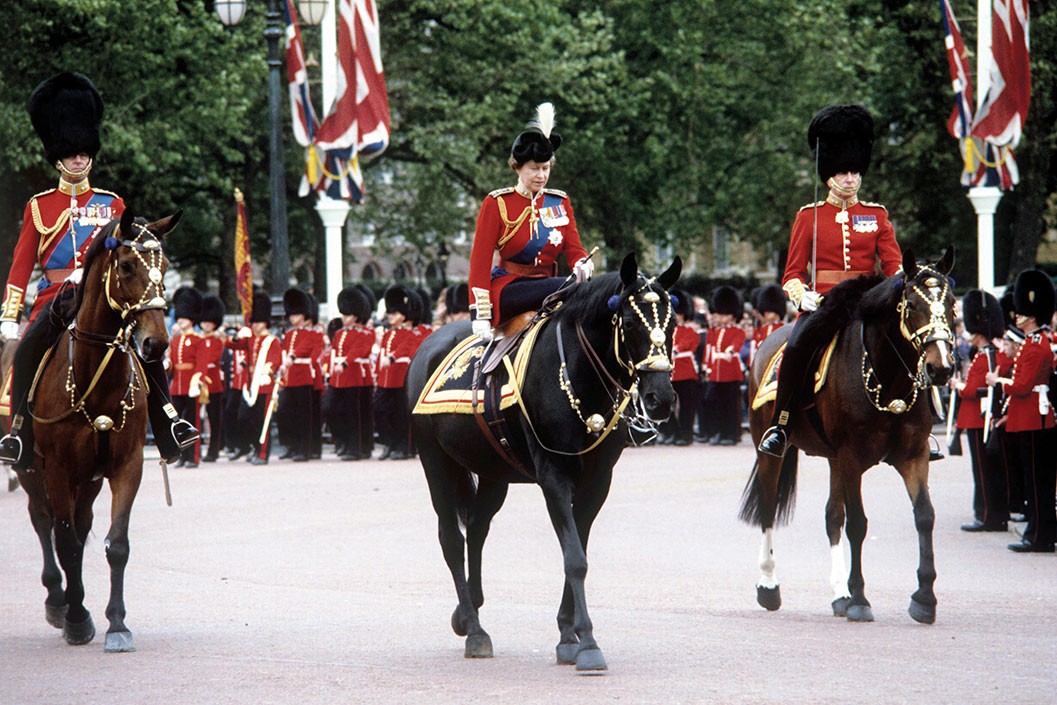Those of us who were on the royal tour in the spring of 2005 to celebrate the centenaries of Saskatchewan and Alberta remember the rain, the whipping wind and the plunging temperatures — but also the “stiff upper lip” of Queen Elizabeth II. READ MORE>>
The Monarch and the Mounties
The Queen’s favourite horse was born in Saskatchewan, a gift from her beloved Mounties. She rode the regal black filly for the annual Trooping the Colour for 18 consecutive years from 1969 to 1986

Queen Elizabeth II on Burmese during the Trooping the Colour ceremony. At her right is the Duke of Edinburgh.
Those of us who were on the royal tour in the spring of 2005 to celebrate the centenaries of Saskatchewan and Alberta remember the rain, the whipping wind and the plunging temperatures — but also the “stiff upper lip” of Queen Elizabeth II.
The Queen and Prince Philip were coming first to Regina for the unveiling of a statue on the grounds of the legislature to honour Burmese, a horse she rode for 18 years. Burmese, a filly, was not only the Queen’s favourite horse, but a local celebrity, having been bred at Maple Creek, west of the provincial capital. She had been given as a gift to the Queen in 1969, when the RCMP Musical Ride was performing in the United Kingdom.
The Mounties, of course, wanted the outdoor event to go off without a hitch. They had even done a dry run with the horse-drawn landau that would take the Royal couple to the Queen Elizabeth II Gardens by the Legislative Building, where the magnificent sculpture by Susan Velder was waiting to be unveiled in the newly named gardens. Knowing rain was certainly in the forecast, they did the dry run with the top up for protection.
The Queen would have none of it. “No, no, no,” she told the Mounties when she and Philip arrived at the start of the procession. “Top down.”
The people, many of them schoolchildren waving tiny flags, had come expecting to see their Queen, and see her they would. She would, as always, do her duty.
At 79, in 2005, she was still very much the 21-year-old Princess Elizabeth who stood in front of a crowd in South Africa and announced, “It is very simple. I declare before you all that my whole life, whether it is long or short, shall be devoted to your service.”
Five years later she was Queen. On February 6 of this year, she marked 70 years as Monarch, her life far, far more long than short.
The day after the unveiling of the statue to her beloved Burmese, she was off to the RCMP training centre where she and Philip would lay wreaths to honour the 207 men and women who had been killed in the world’s most recognizable policing uniform. Some 600 veterans, officers and cadets were assembled on the parade grounds to be inspected by the Royal couple, the inspections often including long conversations on where they were from and how long they had served or expected to serve.
The Royal couple also met privately with the families of four young Mounties who had been slain in early March just outside Mayerthorpe in northwest Alberta. The shooter then took his own life.
The Royals and families gathered in the little white chapel just off the parade grounds to honour the memories of Leo Johnston, 32, Anthony Gordon, 28, Peter Schiemann, 25, and Brock Myrol, 29. Myrol had been on the job only two weeks; his family had been here only a short time earlier to celebrate with him, now to mourn.
Kim Gordon was pregnant with a child due in July and had already decided to name the arriving boy Anthony, after her lost husband. Anthony had been called in on his day off. As she recounted, “When they called him in, he did not grumble. He simply said, ‘I’m on my way.’”
Duty — the permanent bond between the monarchy and the Canadian Mounties.
It is a heartfelt connection that stretches back to the 19th century, when Prime Minister Wilfrid Laurier approved a plan to send 25 members of the North-West Mounted Police and 28 horses to Queen Victoria’s Diamond Jubilee celebrations in England. Commissioner Lawrence Herchmer was so determined his men looked sharp that he ordered up a new uniform that combined a Stetson hat with red serge, thereby guaranteeing the Canadian “Mounties” instant recognition forever after.
It was King Edward VII who granted the prefix “Royal” in 1904 in recognition of their service in the Boer War, from which they returned with the equally recognizable “Strathcona” boots.
No monarch has so loved Mounties — and, by extension, horses — more than Elizabeth II. They attended all her formal celebrations; she never failed to pay special attention to them during reviews on any royal tour of Canada, the 2005 visit being her 21st.
In 1973, on the 100th anniversary of the force’s founding, she had also been in Regina, at this same parade ground. It was a time in which the RCMP was undergoing considerable criticism for its treatment of Indigenous Peoples and its wiretapping operations of university activists.
“I particularly value your close association with my family,” Queen Elizabeth told the gathering. “The force has been represented at every coronation since King Edward VII’s, and I well remember the splendid detachment at my own coronation.”
She would also never forget Burmese, the coal black filly from Saskatchewan. She had, after all, been aboard Burmese that alarming day in 1986 when, at a Trooping the Colour ceremony along the mall, a disturbed young man ran up and fired six blank shots at her. Both horse and rider flinched, but both quickly recovered and carried on.
Both simply doing their duty.
Journalist and author Roy MacGregor covered the 2005 royal tour for The Globe and Mail.
